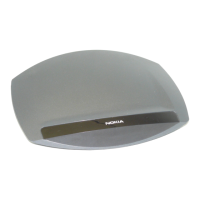
Do you have a question about the Nokia IP40 and is the answer not in the manual?
Introduces the Nokia IP40 Security Platform and its available versions.
Details key features like connectivity, firewall, management, and security services.
Outlines network requirements and provides an overview of the IP40's physical panels.
Covers pre-installation steps, including TCP/IP configuration for various OS.
Illustrates proper network cabling topologies for connecting the Nokia IP40.
Guides the initial login process, password setting, and basic configurations.
Details logging on procedures and secure access methods for the IP40.
Explains various connection methods and configuration approaches for the IP40.
Covers centralized management of multiple IP40 devices.
Guides configuring the Internet connection using setup wizards or manual settings.
Details settings for cable modem and DSL connections, including MAC cloning.
Provides steps for manually configuring internet settings via GUI.
Covers advanced network configurations like DHCP, IP addresses, and NAT.
Guides setting up a Demilitarized Zone for enhanced security.
Explains static NAT for IP mapping and static routes for packet routing.
Defines firewall security levels and configures virtual servers for inbound connections.
Guides creating, allowing, blocking, and deleting firewall rules.
Allows designating a host for unlimited incoming/outgoing connections.
Covers changing passwords and managing user accounts.
Guides setting up remote VPN access and RADIUS authentication.
Details configuring secure shell and telnet access methods.
Introduces SNMP and covers its configuration via GUI and CLI.
Details setting SNMP community name and trap generation.
Explains VRRP for eliminating single points of failure in networks.
Covers dual homing for uninterrupted ISP links and modem parameters.
Explains BGP for detecting VPN failures and activating alternative links.
Covers BGP routing, route advertisement, peer management, and prefix lists.
Covers configuring HA options like WAN failover and criteria for path selection.
Introduces OOB management for remote access when local connection fails.
Guides configuring modem settings and secure access via SSH/HTTPS.
Describes configuring IP40 remotely using a special mode.
Guides configuring host name, date/time, and system logging.
Covers exporting/importing configurations and upgrading firmware.
Details installing product keys and configuring Dynamic DNS.
Explains resetting the IP40 to factory default settings via GUI or hardware.
Lists available reports: Event Log, Active Computers, Connections, VPN Tunnels.
Details event log categorization and viewing active computers with license status.
Covers viewing active connections, VPN tunnels, and diagnostic summaries.
Explains VPN functionality and setting up the IP40 as a VPN server.
Guides configuring various VPN scenarios and site-to-site connections.
Details specific VPN client-to-gateway scenarios involving Tele and Satellite X.
Covers VPN connectivity with Check Point and Cisco PIX firewalls.
Discusses NAT modes and defining backup VPN gateways.
Introduces subscription services like software updates and content filtering.
Guides connecting to service centers and configuring user accounts.
Details configuring web filtering and email antivirus scanning.
Covers checking and managing software updates locally and remotely.
Explains managing IP40s using Horizon Manager and Check Point LSM.
Introduces debugging commands and configuring debugging levels.
Addresses common questions, including internet access problems.
Troubleshoots forgotten passwords and VPN connection failures.
Covers viewing firmware status and resetting the device to factory defaults.
Explains failsafe mode and procedures for upgrading firmware.
Guides running diagnostics to view hardware, firmware, and network status.
Lists physical and electrical specifications of the Nokia IP40.
Provides essential safety instructions for installing and operating the Nokia IP40.
Outlines license terms, restrictions, and Nokia's ownership of intellectual property.
Details warranty terms, disclaimers, and limitations of liability.
Defines key terms and specifies license terms for users.
Outlines agreement terms, termination conditions, and IP ownership.
Declares product conformity to safety and EMC standards.
Provides FCC compliance information and user guidance on interference.